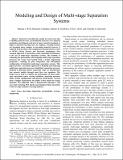Modeling and Design of Multi-stage Separation Systems
Author(s)
Wolf, Malima I.; Colledani, Marcello; Gershwin, Stanley B.; Gutowski, Timothy G.
DownloadGutowski_Modeling and.pdf (2.515Mb)
PUBLISHER_POLICY
Publisher Policy
Article is made available in accordance with the publisher's policy and may be subject to US copyright law. Please refer to the publisher's site for terms of use.
Terms of use
Metadata
Show full item recordAbstract
Interest in recycling has surged in recent years due to shifting material costs, environmental concerns over material production and disposal, and laws in many countries designed to improve material recycling rates. In response, recycling systems are becoming more complex as increasing material recovery is required from products with complicated material mixtures such as WEEE (Waste Electric and Electronic Equipment). One common approach to increasing system separation performance is the use of multi-stage separation systems. The problem of estimating the performance and designing multi-stage separation processes has rarely been tackled from a system engineering perspective, resulting in poor integration and sub-optimal configuration of industrial multi-stage separation systems. This paper presents a systematic approach to modeling and analyzing multi-stage separation processes. Individual separation processes modeled as Bayesian binary separation steps are incorporated into network models through mass flow rate equations. The model can be used to evaluate the performance of these multi-stage separations under varying conditions, informing decisions about system configuration and process performance. Several basic examples demonstrate the utility of this model for design decisions. The industrial value is demonstrated through a real case study featuring PET plastic and aluminum flake separation in the beverage container recycling industry.
Date issued
2010-07Department
Massachusetts Institute of Technology. Department of Mechanical EngineeringJournal
2010 IEEE International Symposium on Sustainable Systems and Technology (ISSST)
Publisher
Institute of Electrical and Electronics Engineers
Citation
Wolf, M.I. et al. “Modeling and Design of Multi-stage Separation
Systems.” Sustainable Systems and Technology (ISSST), 2010 IEEE International Symposium on. 2010. 1-6. © Copyright 2010 IEEE
Version: Final published version
ISBN
978-1-4244-7094-5